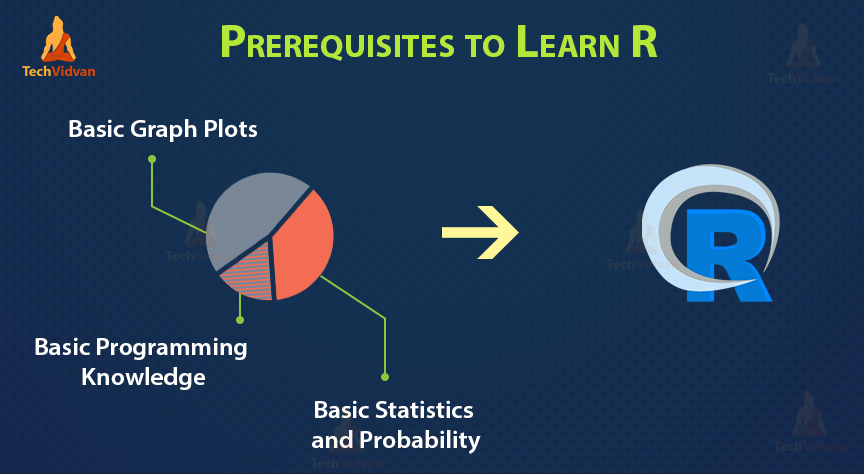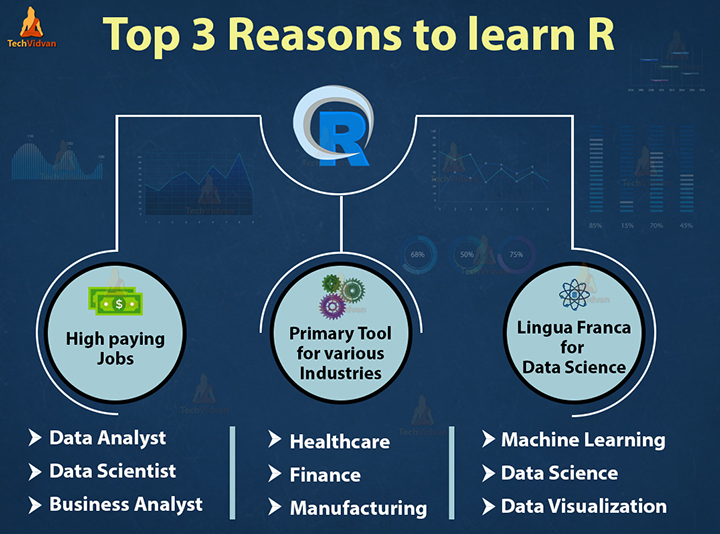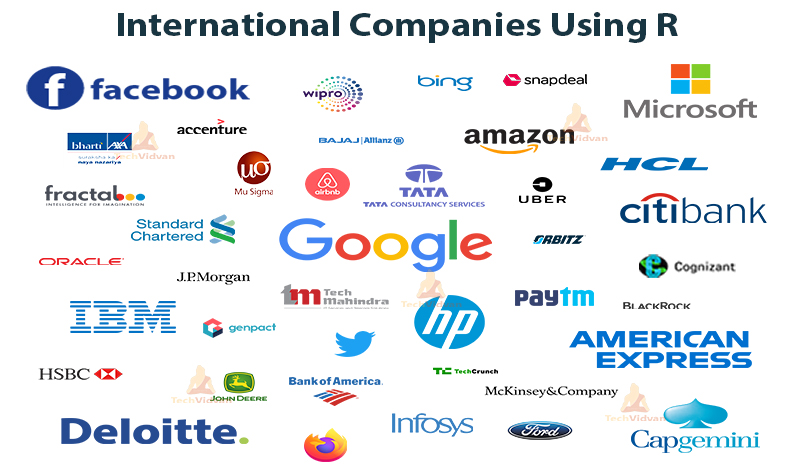R Tutorial – ‘Coz you wished to be a Data Scientist
This R tutorial by TechVidvan is designed to be an all in one package to answer all your questions about what is R and how it can be your perfect partner.
Data is called the crude oil of the IT industry. Unlike oil, data is being generated in an increasing amount and is getting more and more complex every day. This has led to an ever-increasing demand for Data Scientists in various industry sectors.
R and Python are the two leading programming languages when it comes to Data Science.
R Tutorial
In these TechVidvan R tutorials, we are going to introduce you to the bright and shining world of R and its wide range of capabilities.
This R tutorial is basically aimed for beginners getting started with R programming language and data science, as well as experienced users looking to brush-up the basics.
We will start with the basic questions of what, when, why, who, and then take a look at the future opportunities. So let’s get cracking!
Let’s look at the topics we will cover in this R tutorial:
- What is R?
- History of R
- Before You Start Learning R
- Features
- Why Learn R?
- R vs The World
- Pros and Cons
- Companies using R
- Future Scope and Career Opportunities
What is R?
Now the important question is What exactly is R?
R is an open-source programming language and environment used for statistical analysis, data visualization, and data science.
Being open-source, R has a massive community that continuously works to improve the environment as well as helps members worldwide to improve and innovate.
R can be used for data analytics, statistical analysis, as well as machine learning purposes.
R is compatible with a number of different technologies and is highly flexible.
It has over 10,000 different libraries and packages to enhance and add on to its already significant capabilities. It also has graphics libraries for static as well as dynamic graphics.
History of R
R is an extension of the S-programming language, which was created by John Chambers at Bell Laboratories (formerly AT&T, now Lucent Technologies) in 1976. S was a premiere tool for statistical research, but it wasn’t very feasible outside scholarly research.
In 1992, Ross Ihaka and Robert Gentleman created R at the University of Auckland, New Zealand, as a tool that their students could learn and use easily. Ihaka and Gentleman released the initial version in 1995, and a stable beta version was released in 2000. Since then, it is maintained by the R Development Core Team.
Before You Start Learning R
As such, there are no mandatory prerequisites to R.But before you jump into learning R, it is recommended to have some basic knowledge of a few topics. These include:
- Basic understanding of statistics, mathematics, and probability
- General understanding of data science and the processes involved.
- Basic Understanding of various types of graphs and data representation techniques.
Features of R
R is packed with many exciting features and limitless possibilities. Some key features of the R programming language:
- R has a massive community that works tirelessly to improve and add upon R’s abilities. CRAN or Comprehensive R Archive Network has over 10,000 packages or extensions that can be used from producing high-definition graphics to creating interactive web-apps.
- R can perform complex mathematical and statistical operations on vectors, matrices, data frames, arrays, and other data objects of varying sizes.
- R is an interpreted language and does not need a compiler. It generates a machine-independent code that is easy to debug and is highly portable.
- R is a comprehensive programming language that supports object-oriented as well as procedural programming with generic and first-class functions.
- It supports matrix arithmetic.
- R can present data graphically. With static graphics, producing production quality visualizations and extended libraries providing interactive graphic capabilities, data visualization, and data representation becomes very easy. From concise charts to elaborate flow diagrams, all are well within R’s repertoire.
- R can be used throughout the data analysis process. It helps to gather the data, to clean it, to investigate it, to model it, and finally, it helps you to compile the results in an eye-catching and easy to understand reports with R markdown. R can also help you build apps to show the results to the world.
- It can use distributed computing to process large datasets parallelly.
- R has packages that allow it to interact with multiple databases of different formats. It can also interact with various database management systems.
- R is compatible with many other programming languages like C, C++, Java, Python, etc.
These are just a glimpse of what R offers. But if you decided to learn R programming, then you must see some more exciting R features.
Why Learn R?
Why one should learn a specific technology is a good question to ask. Is it worth my time and effort? R is among the most demanded scripting languages when it comes to data science.
Here are a few reasons why learning R is a must for a data scientist:
- It is the standard tool for performing data analysis and statistical operations.
- R has strong data visualization capabilities. It can make production quality graphics, which makes presenting data in an easy to understand way possible.
- R makes data gathering processes like web scraping very easy.
- It is platform-independent, which means it can be used across all operating systems.
- Several industries like health, finance, banking, e-commerce, manufacturing, and much more use R as their primary tool for data modeling.
- It integrates seamlessly with other technologies like Hadoop, which makes an ideal combination for large scale data processing.
- R can be used for data analysis, statistical analysis, as well as machine learning.
- R is free due to its open-source GNU licensing and can be installed and used by anyone.
- With a large number of packages and libraries available for it, R is one of the most flexible programming languages in the world.
- Academic research, healthcare industry, government surveys, finance industry, banking industry, retail and manufacturing sectors, e-commerce companies as well as tech giants like Facebook, Google, and Amazon all use R for some purpose or the other and, therefore, need R programmers.
- Many more surprising reasons.
If you prefer an online interactive environment to learn R, then the upcoming TechVidvan R tutorials will be the easy go for the beginner.
R vs The World
R is not the only programming language dealing with data science and machine learning. Here are a few advantages R has over the others like SAS:
- Open source: R is an open-source environment. It is cost-effective for projects of any size and is widely available.
- Advanced graphics: R has various libraries and packages available for plotting attractive and elegant graphs. These can also be used to create highly interactive graphics for data-driven storytelling, as well.
- Data handling and storage: R’s various packages allow for very robust data handling and storage.
- Options and alternatives: Due to the large number of packages available for R, there are always several alternative ways to solve a problem.
- Community support: R has more than 2 million users worldwide. Due to its popularity, R users enjoy great community support.
- R markdown: You can make attractive and concise reports of your findings and results using R markdown, which seamlessly combines plain text with code and visualization graphics.
- Compatible with various other technologies: R can integrate with a number of different technologies and programming languages.
- Cross-platform compatible: R can run on any OS, in any software environment, without any modifications and compatibility issues.
Pros and Cons of R
It is a fact that every technology has positive as well as negative aspects. Here are some advantages and disadvantages of the R programming language:
Advantages of R
- R is a cross-platform environment and can run on any operating system.
- It is a comprehensive statistical analysis tool. New technologies and ideas often appear first in the R community.
- R has superb graphical capabilities that are far better than any other statistical language.
- It can be used by anyone, run anywhere at any time, and can even be sold under the conditions of the license.
- R has more than 15,000 packages available, making it one of the most flexible programming languages in the world.
- It is an interpreted language, which means that it is interpreted and not compiled, which makes R programs faster to run.
- R is compatible with various database management systems like Oracle, SQL, and even NoSQL databases like Cassandra and MongoDB.
- It can employ processing techniques like parallel processing and distributed computing to process large datasets faster and more efficiently.
Disadvantages of R
- R commands don’t concern with memory management, and therefore R can consume a large amount of available memory.
- Due to a large number of packages available and the existing redundancy among them, some packages can be of poor quality.
- R doesn’t have dedicated customer support to solve the issues which the users are facing.
Companies using R
A lot of companies in various sectors use R for a wide variety of purposes. It has a wide range of available libraries or packages, making it a literal jack of all trades. The question who can use R? Can be easily answered with …. Everyone!!
Here are some big names and industry sectors that are already using it:
- Social media companies like Facebook and Twitter use R for behavior analysis of their users, to analyze trends, and to improve online marketing strategies.
- E-commerce companies like Amazon use R to identify potential customers, to judge the effectiveness of their advertising campaigns, and to analyze customer feedback and sentiment.
- Banking and finance firms use it for risk assessment, fraud detection, to predict stock market trends, and to assist in the business decision-making process.
- Uber and other transportation companies use it to improve their pathfinding and navigation algorithms.
- Airbnb uses R to improve their listings and to isolate factors resulting in better ratings and business.
- Search engines such as Google use it to improve their search results.
- R is also used in the bioinformatics sector to analyze genetic sequences and to assist in pharmaceutical research.
- R is a statistical analysis tool. It was created as a research aid and is still used for academic and statistical research.
- Ford motors use R along with Hadoop to analyze customer feedback and also to analyze social media to find user opinions that may help them in improving their products and also to predict market hikes and demands.
Future Scope and Career Opportunities in R
In today’s day and age, the knowledge gained through the big data is crucial to a business’ survival. Recent surveys state that there are about a million jobs available for data scientists worldwide.
The R environment and community represents the cutting-edge in the field of data science. R programmers can find various types of jobs in any sector of their choice. R programmers fit well in roles like data analyst, business analyst, data visualization expert, etc..
R’s data processing and visualization abilities make it the perfect tool for business intelligence. It makes communicating a data scientist’s research to a business-minded executive very simple.
Many large and small businesses and corporations use R for one purpose or the other and are always on the lookout for talented data scientists and analysts.
But what matters here is you and not the big companies. Find out how R can help your career.
Summary
In this article, we learned the what, why and who of R, its brief history as well as its future scope, and some prerequisites for making the process of learning the R programming language smoother.
Data science is a rapidly growing industry, and the R community is leading in terms of innovation in it.
R has become a well-known name amongst programming languages. It has also become an industry standard when it comes to data science and is expected to keep growing in popularity.
After this R tutorial, explore Real-world application of R Programming.
Feel free to ask any queries related to R tutorial and our experts at TechVidvan will be happy to help you.
Keep Learning!!



